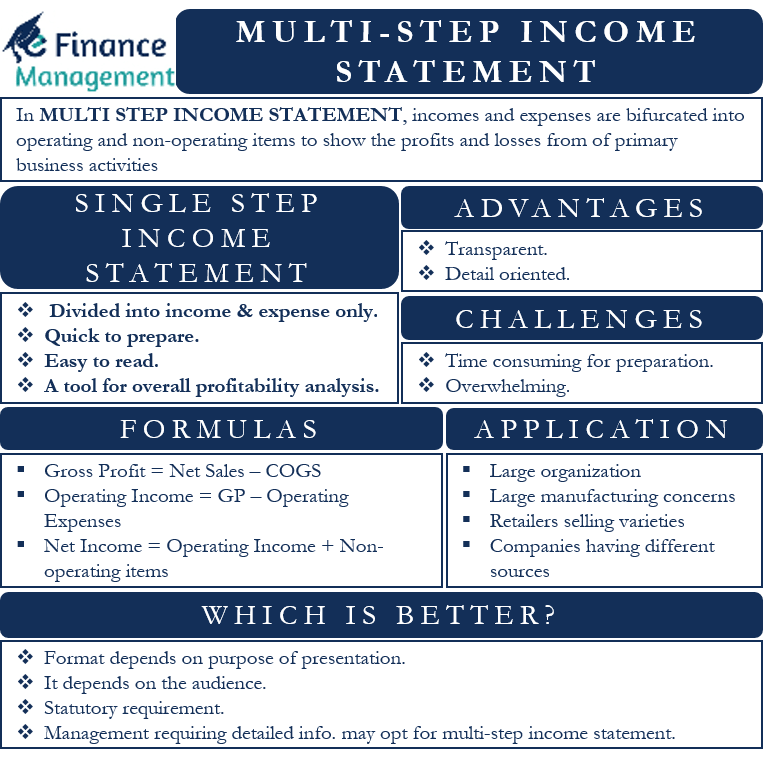As the name indicates, a multi-step income statement shows multiple steps in Income Statement. To understand this concept in a better way, we have to first understand what is an income statement and a single-step income statement. Let us see more about Multi-Step Income Statement and Single-Step Income Statement.
What is an Income Statement?
- It is a Financial statement. And it reflects profit earned during a reporting period.
- Moreover, the reporting period could be monthly, quarterly, or yearly.
- However, the company can define a reporting period based on project duration in a very rare occurrence.
- The statement is divided into top and bottom numbers
- The top number indicates the total revenue accrued during the period.
- Whereas the bottom number is the profit earned or accrued.
- And, Profit = Revenue – Expenses
Single Step Income Statement
- It is a direct, simple statement and has no categories. It is divided into two parts only, i.e., income and expenses.
- Advantages of Single Step income statement
- Can be prepared quickly
- Easy to Read
- Fast to comprehend
- From the above discussions, we can conclude
- The single-step method is simple, and
- It is an excellent tool for overall profitability analysis
Example
| Particulars | $ |
| Revenues & Gains | |
| Revenue from operations | 80,000 |
| Interest revenue | 1,200 |
| Profit on sale of assets | 4,500 |
| Total | 85,700 |
| Expenses & Losses | |
| Cost of goods sold | 60,000 |
| Commission | 700 |
| Office supplies expenses | 1,500 |
| Advertisement expense | 2,000 |
| Loss from sale of investment | 1,000 |
| Interest | 2,500 |
| Total | 67,700 |
| Net Income | 18,000 |
Multi-Step Income Statement
A Multi-Step Income Statement is a detailed statement reflecting profits or losses from an organization’s operating and non-operating activities for a specific reporting period. It differentiates the operating and non-operating incomes and expenses, which ultimately shows earnings from main business activities as compared to non-essential activities.
- As discussed earlier, a multi-step income statement categorizes the Income Statement.
- The first item in FS is Revenue: The revenue is classified into two
- Operating Revenue = Related to the Business, and
- Non-operating Revenue = Anything that does not pertain to the main business activity
- Example: Interest on Fixed Deposit
- The next item is expenses: The expenses are classified into
- Operational Expenses:
- These are further classified either based on cost center or department
- Moreover, anything that cannot be segregated should be treated as other costs
- Operational Expenses:
- The first item in FS is Revenue: The revenue is classified into two
- In this method, we use different formulae to arrive at the profitability
Advantages
- Transparency
- Detail Oriented
Challenges
- Time-consuming for preparation
- Overwhelming
Example
| Particulars | $ |
| Sales | 80,000 |
| Cost of goods sold | 60,000 |
| Gross Profit | 20,000 |
| Operating expense | |
| Administrative expenses | |
| Office supplies expense | 1,500 |
| Selling expenses | |
| Advertisement expense | 2,000 |
| Commission | 700 |
| Total operating expense | 4,200 |
| Operating income | 15,800 |
| Non-operating items | |
| Interest revenue | 1,200 |
| Profit on sale of assets | 4,500 |
| Loss from sale of investment | -1,000 |
| Interest | -2,500 |
| Total non-operating items | 2,200 |
| Net Income | 18,000 |

Formats of Reporting
- The main purpose of any income statement is to show the profit
- But a single step arrives at a profit with basic information
- Whereas a multi-step approach groups the information in a better format.
Formulas
Formulas for calculating incomes in a multi-step income statement are:
Gross Profit = Net Sales – Cost of Goods Sold
Operating income = Gross Profit – Operating Expenses
Net Income = Operating income + Non-Operating items
Application of Multi-Step Income Statement
Large and complex organizations generally use multi-step income statements. Companies having different sources of revenue should create multi-step income statements. This would include large manufacturing concerns and retailers selling a wide variety of products. Public companies also maintain multi-step income statements for disclosure requirements under laws.
Which is better?
- Firstly, the format depends upon the purpose of the presentation of Financial Statements.
- Secondly, it depends upon the audience.
- Thirdly, for statutory reporting, the formats are preset. However, for management reporting,
- If the management wishes to go into detail, a Multi-step Income statement is beneficial.
- Otherwise, we can go with the single-step income statement
- If accurate, reliable data is available, the multi-step approach is advisable,
- Sometimes time and gathering data could be a constraint, then a single-step approach is more advisable.

